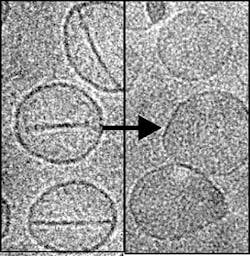CANCER TREATMENT/NANOTECHNOLOGY: Light-activated chemotherapy delivery limits side effects
With standard drug-delivery methods, toxic chemotherapy cocktails affect healthy tissue in addition to cancer. The result is unwanted side effects and decreased drug effectiveness. But new "nanoballoons," developed by researchers at the University at Buffalo (UB; New York), could serve as delivery vehicles to target chemotherapy drugs more precisely. Then, when hit by red laser light, the modified liposomes pop open to deliver concentrated doses.1 The work could not only improve cancer treatment, but also facilitate research.
Consisting of porphyrin (an organic compound) and phospholipid (a fat similar to vegetable oil), the nanoballoons, or porphyrin-phospholipid (PoP) liposomes, are delivered intravenously. And because they encapsulate the toxic drugs, they diminish the drugs' effect on healthy tissue.
In laboratory experiments with mice, the researchers aimed a red laser at the target sites in the body, triggering the nanoballoons to release drugs. Once the laser is turned off, the nanoballoons close, taking in proteins and molecules that might induce cancer growth. Doctors using the technique could draw blood or take a biopsy to capture the liposomes—and thus retrieve a "chemical snapshot" of the tumor's environment, which is otherwise very difficult to assess.
Jonathan Lovell, Ph.D., UB assistant professor of biomedical engineering, admits that it is "still a bit of a mystery" why the liposomes open in reaction to red laser light, which is "otherwise harmless." He plans now to work to better understand the phenomenon and to optimize the process. Lovell, who received one of the National Institutes of Health's Early Independence Award grants to fund high-risk, high-reward research, hopes to begin human trials within five years. The UB team collaborated with researchers from the University at Albany (NY); Roswell Park Cancer Institute (also in Buffalo); and the University of Waterloo and McMaster University (both in Ontario, Canada).
1. K. A. Carter et al., Nat. Comm., 5, 3546 (2014); doi:10.1038/ncomms4546.
